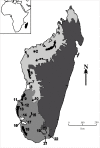Comparing Methods for Prioritising Protected Areas for Investment: A Case Study Using Madagascar's Dry Forest Reptiles
- PMID: 26162073
- PMCID: PMC4498610
- DOI: 10.1371/journal.pone.0132803
Comparing Methods for Prioritising Protected Areas for Investment: A Case Study Using Madagascar's Dry Forest Reptiles
Abstract
There are insufficient resources available to manage the world's existing protected area portfolio effectively, so the most important sites should be prioritised in investment decision-making. Sophisticated conservation planning and assessment tools developed to identify locations for new protected areas can provide an evidence base for such prioritisations, yet decision-makers in many countries lack the institutional support and necessary capacity to use the associated software. As such, simple heuristic approaches such as species richness or number of threatened species are generally adopted to inform prioritisation decisions. However, their performance has never been tested. Using the reptile fauna of Madagascar's dry forests as a case study, we evaluate the performance of four site prioritisation protocols used to rank the conservation value of 22 established and candidate protected areas. We compare the results to a benchmark produced by the widely-used systematic conservation planning software Zonation. The four indices scored sites on the basis of: i) species richness; ii) an index based on species' Red List status; iii) irreplaceability (a key metric in systematic conservation planning); and, iv) a novel Conservation Value Index (CVI), which incorporates species-level information on endemism, representation in the protected area system, tolerance of habitat degradation and hunting/collection pressure. Rankings produced by the four protocols were positively correlated to the results of Zonation, particularly amongst high-scoring sites, but CVI and Irreplaceability performed better than Species Richness and the Red List Index. Given the technological capacity constraints experienced by decision-makers in the developing world, our findings suggest that heuristic metrics can represent a useful alternative to more sophisticated analyses, especially when they integrate species-specific information related to extinction risk. However, this can require access to, and understanding of, more complex species data.
Conflict of interest statement
Figures


Similar articles
-
Extinction risks and the conservation of Madagascar's reptiles.PLoS One. 2014 Aug 11;9(8):e100173. doi: 10.1371/journal.pone.0100173. eCollection 2014. PLoS One. 2014. PMID: 25111137 Free PMC article.
-
Deforestation and plant diversity of Madagascar's littoral forests.Conserv Biol. 2006 Dec;20(6):1799-803. doi: 10.1111/j.1523-1739.2006.00562.x. Conserv Biol. 2006. PMID: 17181815
-
Comparison of marine spatial planning methods in Madagascar demonstrates value of alternative approaches.PLoS One. 2012;7(2):e28969. doi: 10.1371/journal.pone.0028969. Epub 2012 Feb 16. PLoS One. 2012. PMID: 22359534 Free PMC article.
-
Madagascar's extraordinary biodiversity: Threats and opportunities.Science. 2022 Dec 2;378(6623):eadf1466. doi: 10.1126/science.adf1466. Epub 2022 Dec 2. Science. 2022. PMID: 36454830 Review.
-
Environmental drivers of Cheirogaleidae population density: Remarkable resilience of Madagascar's smallest lemurs to habitat degradation.Ecol Evol. 2021 May 2;11(11):5874-5891. doi: 10.1002/ece3.7449. eCollection 2021 Jun. Ecol Evol. 2021. PMID: 34141190 Free PMC article. Review.
Cited by
-
Overview of Reptile Diversity from Bobaomby Complex, Northern Tip of Madagascar.Animals (Basel). 2023 Nov 1;13(21):3396. doi: 10.3390/ani13213396. Animals (Basel). 2023. PMID: 37958151 Free PMC article.
-
Strengths and complementarity of systematic conservation planning and Key Biodiversity Area approaches for spatial planning.Conserv Biol. 2025 Apr;39(2):e14400. doi: 10.1111/cobi.14400. Epub 2024 Oct 15. Conserv Biol. 2025. PMID: 39403036 Free PMC article. Review.
References
-
- James AN, Gaston KJ, Balmford A (1999) Balancing the Earth’s accounts. Nature 401: 323–324. - PubMed
-
- Bruner AG, Gullison RE, Balmford A (2004) Financial costs and shortfalls of managing and expanding protected-area systems in developing countries. BioScience 54: 1119–1126.
-
- Jenkins CN, Joppa L (2009) Expansion of the global terrestrial protected area system. Biol. Conserv. 142: 2166–2174.
Publication types
MeSH terms
LinkOut - more resources
Full Text Sources
Other Literature Sources
Research Materials

